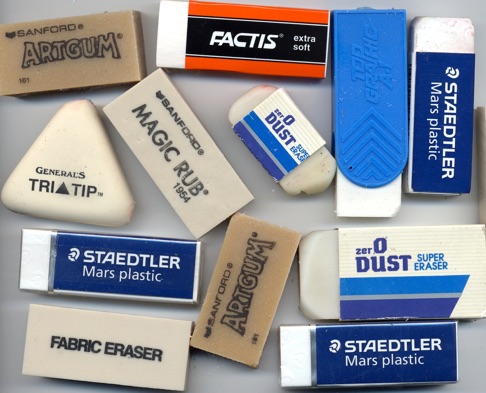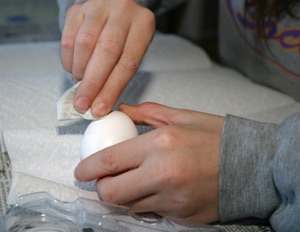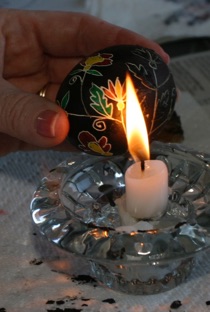Removing Pencil Lines

My collection of erasers
Just as there are countless ways to skin a cat, there are many ways to get rid of pencil lines. Not each method is good in every case – you must pick the right one for the stage your pysanka is in. There are three basic principals:
1. Avoidance.
This may seem obvious, but the best way to avoid having pencil lines is to not make them in the first place. When you draw lines on your egg, draw only the minimum necessary, and not every single minute little detail of the design. I only write enough pencil lines to divide the egg and allow me to place my motifs evenly. Also, too, use a medium (#2) or softer pencil to draw the lines; while harder pencils leave lighter lines, softer pencils leave lines that are easier to remove.
2. Removal on a white egg.
There are two reasons to remove pencils lines from a white egg. The first is if you’ve made a mistake or two...or want to get rid of all the lines and start over. Any of the methods below will work, but a little bit of saliva on a Q-tip or tissue is great for removing a spot or two.
The second reason is to clean off all the remaining lines before you begin dyeing the egg. If you are making a two-color egg, and one of those colors is white, or if you are making an egg with a lot of white in it, it is a good idea worthwhile to remove as much pencil as possible before dyeing the egg in the first color. This is especially true if you want a relatively light / non-black final color. Black usually hides pencil lines well; colors such as red or light blue do not.
Water:
In a pinch, a little bit of water on a pice of tissue or paper towel can be used to rub away a stray pencil mark. Rubbing too hard can damage the egg’s cuticle, so don’t use this method if others are available. Note, too, that many people saliva for this same purpose, particularly mothers wiping their children's faces.
Soap:
Ivory dish soap can safely be used to wash an egg, and it will usually remove all
surface crud, including pencil marks, in the process. This is not the method of
choice for removing pencil marks, but might come in handy if you have a lots of
marks to erase, or a special egg (goose, duck, etc.) that you’ve messed up the
design on and want to start over.
Put a drop or two of Ivory (classic scent only) on the egg, and use a wet sponge
or washcloth (soft type) to gently rub away the pencil marks. Rinse very well.
Afterward, soak the egg briefly in a vinegar rinse to restore the pH.
Saliva:
While neither aesthetic nor necessarily hygienic, a bit of spit on a tissue is actually quite good for removing a stray pencil mark. I wouldn’t suggest it for mass removal of lines, but for a line that’s gone awry, it works. Many pysankarky swear by it, too........
Goof-Off Wipes:
I consider these wipes the greatest invention since sliced bread. They are wet wipes that remove pencil marks from any surface like magic. (Please note that they are NOT the same thing as Goof Off liquid, which is an organic solvent useful for removing wax.)
I now use them to routinely wipe down my pysanky after I am done applying wax to the white shell. Pencil lines will show up through later colors, except for the very dark ones like black or royal blue, and they are more difficult to remove once an egg has been dyed.
Pencils lines being removed with a Goof-Off wipe
I really like these wipes, and have gotten into the habit of wiping down all my pysanky when I finish waxing on white and before putting the egg into the vinegar rinse. I reuse the wipes until they shred in my hands. They dry out quickly, but I have found that adding a bit of water to them (or to the entire canister) is all that is needed to make them perfectly functional again. I keep one in shot glass with a bit of water in it in my work space.
In any event, if you see a lot of marks on your pysanka after you’re done applying
the wax to the white shell, it might be worthwhile to remove them, unless you
really need them to complete your design.
In this case, I use Goof-Off Wipes (they use a water-based cleanser) and wipe
down the egg well after I have finished writing the pattern in wax on the white
egg. This will remove the pencil from the areas that will be colored. After using
the wipes, I let the egg dry and then put it briefly into a vinegar rinse before
dyeing.
Since these wipes are water-based, they won’t harm the wax lines, but can
remove the dye. DO NOT use them on colored/dyed eggs. (Please note that
you cannot use regular Goof Off before the wax is removed, as it will remove
wax and destroy your pattern.)
Unfortunately, these wipes are no longer on the market. I have a large supply which I am using sparingly while looking for a replacement. If I find one, I will edit here.
-
3.Removal on a dyed egg.
Once I am finished with the pysanka and have removed the wax, there may still be pencil lines in the white areas. Many pencil lines will come off with the wax when you remove it, because the graphite will dissolve into the molten wax and get wiped off with the wax. But what if they don’t? You can’t use soap, water or wipes, as they will remove the dye as well as any pencil marks. Luckily, there are other things you can do.
In order to remove these lines remove those remaining pencil lines, I use the techniques listed below. I usually simply erase them with an eraser, but sometimes other measures are necessary.
Erasers:
An art gum or white architect’s eraser (see examples in photos above or below) can be used to erase pencil lines. Do not rub very hard, as you might rub off the dye or scratch the cuticle of the egg and cause unsightly marks. Ordinary “pink” erasers may erase well, too, but I worry about their leaving pink residue (especially older ones, as they get quite dry and hard) or scratching more. The eraser at the end of your pencil is probably the worst possible choice, as it often leaves red marks, and gets dry and scratchy quite quickly, especially those on the cheap pencils from China.
I use the white erasers routinely to remove pencil marks from the white areas of my completed pysanky, especially my snowflake pysanky, and find that they do a very good job of pencil line removal.
I generally avoid using an eraser if I am still in process of dyeing, as even the softest and newest eraser can potentially damage the cuticle, scratching it and keeping subsequent dyes from taking properly! Other pysankarky have pointed out to me that they use erasers without causing any damage; I simply don’t feel it’s worth taking a chance.
Heat Dissolution:
Most pencil lines will come off with the wax if you are removing wax using a candle. Really! Graphite readily dissolves in wax or other similar organic substances
(oils, etc.) when they are in a liquid form. Heat speeds up the process,
both by putting wax into a liquid form, and by pushing entropy forwards.
If you find there are still lines left after you’ve removed the wax, it is
worth giving it a second go. Re-cover the problem area with wax or
paraffin (“flood” the area with a wide stylus, or drip directly from a
candle), and then, once the wax has hardened, heat it over a candle
and wipe. Graphite, which pencil “lead” is made of, will dissolve in
the hot wax. This should remove all but the most stubborn lines.
A related technique involves using olive oil. Coat the egg with a bit of
olive oil, and then proceed to remove the wax as you normally would.
The olive oil will, when heated, help to dissolve and remove the
beeswax and pencil lines. Be careful, though, as the olive oil will
make the egg very slippery.
Keep in mind, though, that there are perils to using a candle to remove
wax–scorching and soot deposition. Other methods of heat
removal–oven, heat gun, microwave (empty shells only!!!!!!!!)–might
be better for those with unsteady hands or little experience.
Chemical Dissolution:
I must admit that I haven’t had much luck with chemical dissolution of pencil lines. In theory, it should work well; unfortunately, the chemicals that remove pencil lines also dissolve aniline dyes. This is due to the fact that pencil lead is a mix of graphite, clay and wax, but with clay predominating. Clay dissolves best in water, not in organic solvents. Water dissolves dyes, though, so we are stuck using the organic* solvents, which don’t dissolve dyes, but do dissolve wax, and sometimes will dissolve graphite.
One of the best, albeit more expensive, organic solvents is Ronsonol lighter
fluid, which is simply liquid butane. Put a little bit on a tissue, and gently rub
the pencil lines to remove them. As with other organic solvents, this is a
combustible substance, and potentially toxic, so use it with care, and avoid heat
and open flames! Rubbing too hard with any solvent can rub off your dyes,
and Ronsonol is no exception.
Goof-Off liquid (heavy duty) is another solvent which works fairly well, although
it does a much better job on wax than on pencil lines. (There is a large line
of Goof Off products, none of which is similar to any of the others. Be careful
which ones you buy.) It is a mix of acetone, xylene, and ethylbenzene. Apply it with a tissue, rubbing gently. It is highly flammable and toxic, so be careful. Goof-Off is relatively inexpensive in larger volumes.
Odorless mineral spirits are similarly inexpensive and effective, although less odorous. This solvent is combustible, and composed of a mix of alkanes, including hexane. It is used most commonly as a paint thinner, and can be found both in hardware and art supply stores. It, too, is cheap in large volumes.
Pencil lines can sometimes be removed using Goo-Gone, an inexpensive
household citrus-scented organic solvent. It’s not the best method, or even a
particularly good one, but it is sometimes a useful adjunct. Goo-Gone is best
used for the removal or residual wax and soot – it performs these tasks
admirably.
You can use it in one of two ways. Since it works more slowly than the other
solvent, it is worthwhile coating the egg and letting it sit a while before wiping.
Hold the egg in the palm of your hand, put a few drops of Goo Gone on it , and
roll the egg around to coat it evenly. Use a glove (chemicals can be toxic).
Wait a few minutes to let it work, and then gently dry it with a tissue. Do not
rub very hard – you might rub off the dye!
Or you can apply it with a tissue like the other solvents.
(Note: DO NOT use Goo Gone spray. It is entirely different from the solvent, and contains water, which can wash off your colors!!!!! As with Goof Off, this name is given to a large line of unrelated cleaning products.)
Keep in mind that the lovely citrus scent does not change the fact that this is a volatile organic solvent which is combustible, and should be handled carefully. Keep it away from children, heat and open flames.
__________
* Organic is used here in its chemical sense (non-polar carbon containing), not in its better known natural crunchy-granola sense.
So there you are. As always, the best cure is prevention: keep your pencil lines to a minimum. And it is simpler and better to remove pencil while the egg is white, than to try and do so later when it has been dyed.
Back to Main Pencil Lines page
Back to Main Pysankarstvo page

Removing Pencil Lines










